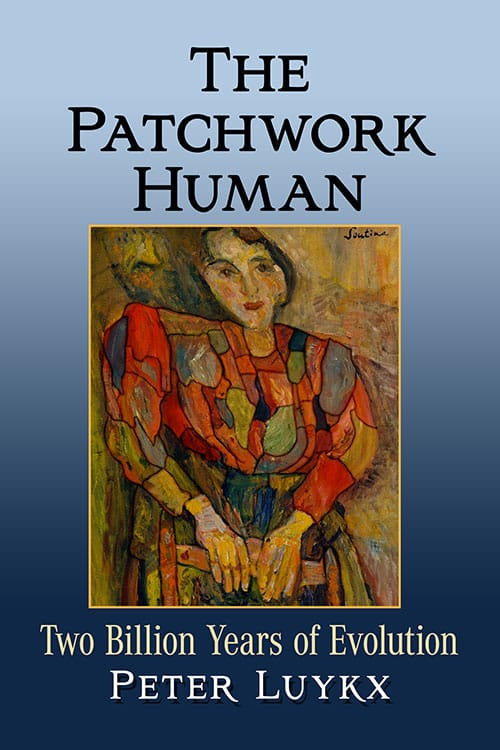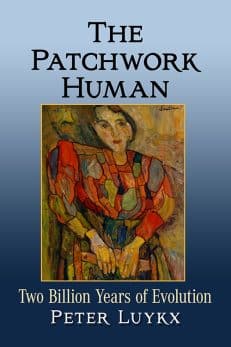The Patchwork Human
Two Billion Years of Evolution
Original price was: $39.95.$19.99Current price is: $19.99.
In stock
About the Book
Life began about four billion years ago on our planet. Like an old patchwork quilt, evolution stitched the human being together from parts of ancient species now long extinct. Like any species, humans have hundreds or even thousands of traits that have been passed down through time. The evolutionary age of our different traits can be told from how widely distributed they are among today’s living creatures.
The book aims to explain some human traits and how we—as social, sexual, language-obsessed technological apes—evolved into our own modern species. Combining hard science with philosophical thought, this work aims to explain where humans have come from, and where we are going. Free of complicated jargon, it breaks down the concept of evolution starting with the human body’s most basic component—our cells. Building from there, chapters explore which traits became inherited over evolutionary time, ultimately projecting what could be next for our species.
About the Author(s)
Bibliographic Details
Peter Luykx
Format: softcover (6 x 9)
Pages: 284
Bibliographic Info: 67 photos, appendices, bibliography, index
Copyright Date: 2022
pISBN: 978-1-4766-8612-7
eISBN: 978-1-4766-4565-0
Imprint: McFarland
Table of Contents
Acknowledgments vi
Preface 1
Introduction: The Patchwork Human, Old and New Parts 4
1. The Human Machine 13
What Do People Think? 14
People versus Machines 14
Mind, Spirit, Soul 16
Matter 19
2. Cells, Genes, and Other Small Parts 23
Cells 23
Molecules Small and Large 26
Chromosomes, Genes, and Proteins 27
3. The Embryo: Construction and Continuity 34
Early Development 35
Continuity 39
4. Evolution: The Process 42
The Process of Evolution 43
Evolutionary Mechanisms 44
Adaptation and the Randomness and Purposelessness of Evolution 51
“For the good of the species” 55
Are We Still Evolving? 56
5. Evolution: The Pattern 59
Darwin’s Tree 59
Evolutionary Genetics 61
Fossils 62
The Genus Homo and Its Ancestors 66
Sea Urchin Interview 70
6. Bigger Is Sometimes Better 74
7. Bilateral Symmetry 80
8. The Sexy Beast, Part I 87
The Biological Basics of Sex 87
Sperm and Egg Logic 92
The Mating Dance: The Logic of Fidelity and Promiscuity 95
9. Up the Mammalian Path 102
Origins 103
Mammary Glands and Milk 106
The Placenta 111
10. Fur 114
Hair Today, Gone Tomorrow 115
11. A Warm-Blooded Animal 120
Mechanisms 121
Evolution 122
12. Upright Living 126
Forelimbs and Hind Limbs 127
Fossil Evidence 129
13. The Brain 136
Brain Development and Structure 137
Some Comparisons 139
Aspects of Brain Evolution 142
Brain Function 145
14. The Sexy Beast, Part II 148
The Penis and the Vagina 151
External Testes 153
How Human Brain Size Influences the Mating System 154
Conspicuous Mammary Glands 155
Sex and Pleasure 158
Ovulation Now? 162
Monogamous or Polygamous? 166
Menopause 169
15. On Being Social 173
Basic Elements of Being Social 175
Teaching and Learning 178
Cooperation 180
Altruism 185
Mind-Reading, or Perspective-Taking 189
Evolutionary Origins of Sociality 193
16. The Truly Musical Animal 198
When? 201
How? The Muses Weigh In 202
As Part of Our Biology, Why Music? 207
17. The Talkative Ape 212
The Anatomy of Speech and Language 213
Features of Human Language 215
Precursors of Language in Animal Communications? 218
An Evolutionary Pathway for Language 221
18. Human Races, Real and Imagined 225
The Concept of Race 226
The Evolution of Human Races 228
Racial Prejudice 234
In Summary 236
19. The Future of the Only Remaining Human Species 238
Homo sapiens Forever 239
A New Species of Homo? 241
Extinction Once and For All 244
Slow Extinction by Climate Change 246
Appendix I: Tissues, Systems, Organs, and Cell Types 251
Appendix II: Some Musical Preferences 256
Background and Further Reading 259
Index 269
Book Reviews & Awards
• “A must read for all interested in learning something about evolutionary traits in humans but who have had no previous training in biology. I am amazed that the author has managed to bring together so many superficially unrelated aspects of human biology… The reader is profiting from the almost 60 years of teaching experience that Luykx has under his belt. His treatment of the literature is so sovereign that it reminds one of David Attenborough’s publications! I particularly enjoyed the writing style of the author: it is simple and straight-forward, the sentences are well-connected making for a smooth flow of thought. Unlike some biology textbooks, this is a book that you can read in bed, on a plane. It’s a gem!”—David Robinson, professor emeritus, Centre for Organismal Studies, University of Heidelberg, Germany
• “What a wonderful book! I loved it. It is entertaining, informative, and often humorous. Genetics professor emeritus Peter Luykx gives us a grand tour of evolution in all its glory—with a focus on how we ‘patchwork humans’ came to be. He tells us what scientists know and what remains a mystery. The writing is excellent, reader-friendly, and crystal-clear. Luykx has a gift for clear and lucid explanations. He makes the science easy to understand through analogies and real-life stories. The book is filled with insight after insight. The interview with a sea urchin is a riot….Once I started [the book], I couldn’t put it down.”—Ira Mark Egdall, physicist, retired aerospace program manager, author of Einstein Relatively Simple
• “As a retired meteorologist with no background in the biological sciences, I found The Patchwork Human by Peter Luykx very illuminating about our biology and evolution as Homo sapiens. The patches of this book are well-stitched together to provide the non-biologist with a clear path through human evolution from the basic biology of all living things to the process and pattern of our own evolution as a species. Surprisingly, and perhaps even humbling, I found the author’s interview with a sea urchin quite revealing. For successful evolution, organisms must adapt to their changing environments and reproduce. Modern Homo sapiens is making rapid, large scale environmental changes that are affecting evolution on this planet. The sea urchin will probably survive these changes, but Homo sapiens may not.”—James M. Gross, Ph.D., retired meteorologist, National Hurricane Center, Miami, Florida
• “A fresh, beautifully written, reader-friendly exploration of the slow, subtle evolutionary processes that resulted in human beings as we know them today. …Surprising and sometimes hilarious comparisons are used to deepen our understanding of the human condition. …An extraordinary read and highly recommended.”—Christine A. Nalepa, Ph.D., research specialist for the North Carolina Department of Agriculture (retired), adjunct associate professor, North Carolina State University
• “The Patchwork Human is such an extraordinary accomplishment. So well researched, so thoughtful, and so insightful. I can’t praise it enough. It is far better than any book I have read covering similar topics.”—Steven Brooke, author and photographer; fellow, American Academy in Rome; adjunct professor, University of Miami School of Architecture
• “This book is an elegant and approachable introduction to the realities of human evolution for the non-scientist. The author explains, among other things, the oddities of the human body, both what they were originally used for, and where they came from. Our present appearance seems to be the result of haphazard mutations which offered valuable benefits to our ancestors, rather than an original masterplan. Our bodies seem to be still evolving to meet the challenge of an ever-changing earth. The author brings us closer to the animal world by revealing the remarkable similarities between humans and the other mammals with which we share our planet. Simple yet clever analogies are used to explain complex genetic concepts. You will never see life on earth in quite the same way again.”—Jeffrey Dorn, former chairman of the Community Advisory Council of Florida International University and a previous vice president of the South Florida Writer’s Association






